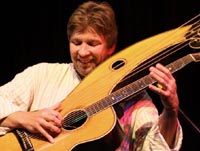
|
Volume 2, Issue 1, December, 2004
|
|
|
GETTING STARTED by Stacy Hobbs |
||
|
This is more or less a preface to my next column so everyone who cares
to be is on the same page. First off, I play a Dyer harp guitar with 6 sub bass strings.
Consequently these workshops will revolve around this type of harp guitar.
Lets begin with the tuning of the sub bass strings and guitar.
For simplicity's sake we’ll establish a “standard” tuning for
the sub basses. Starting low
to high or 12th to 7th, the notes for the sub basses
are G, A, B, C, D, G. Far as I know this is Stephen
Bennett’s brainchild. On page 91 of Robert Carl Hartman’s book The Larson Creations,
there is a Knutsen label with the tuning GABCD written on it. For the six-string guitar section we’ll use standard tuning. |
There are endless variations on tunings. For the scope of the upcoming
columns, standard tuning for the six string is a good starting place. You should have a working knowledge of first position chords and
know some basic music theory. Plus
you’ll need to understand 1,4,5 chord progressions, keys, and their
relative minors. There are many books on the subject of chords, theory, and the like if you do not already posses some rudimentary music knowledge. What string gauges should we use for the sub bass notes?
Here are the ones which work well and can handle variations in
pitch for minor retuning. From 7th to 12th,they are: .042, .056, .059,
.062, .066, .070. Sometimes
I will use the .070 for the 11th string on my 5 sub bass Dyer
instead of the .066. You
could probably go a thousandth of an inch either way with no trouble on
any of these gauges. |
I use D’Addario phosphor bronze and buy them by the 5 pack at our
local music store. I
got these particular gauges from Stephen Bennett who was (and still is)
kind enough to offer such trade secrets. If you decide to tune any string lower than suggested you should
bring the gauge of the string up to accommodate the lesser tension.
More mass for less tension tends to reduce flapping of the bass
string. These suggestions are meant for the rank beginner.
If you have your own tuning and gauges, stick with them. Many of the lessons here will involve concepts, which may be
applied to a variety of tunings! So now we’re set! String up, tune up and lets get started! Stacy |
|
Stacy Hobbs has been performing, recording, and teaching music for the past 22 years. He purchased his first Harp Guitar in 1998, which proved to be his true calling. Visit www.stacyhobbs.net for more! |
||
|
If you enjoyed this page, or found it useful for research, please consider supporting Harpguitars.net so that this information will be available for others like you and to future generations. Thanks!
|
|
All Site Contents Copyright © Gregg Miner, 2004,2005,2006,2007,2008. All Rights Reserved. Copyright and Fair Use of material and use of images: See Copyright and Fair Use policy. |
|
If you enjoyed this article, or found it
useful for research, please consider making a donation to The
Harp Guitar Foundation, |
|
|
|
All Site Contents Copyright © Gregg Miner,2004-2020. All Rights Reserved. Copyright and Fair Use of material and use of images: See Copyright and Fair Use policy. |